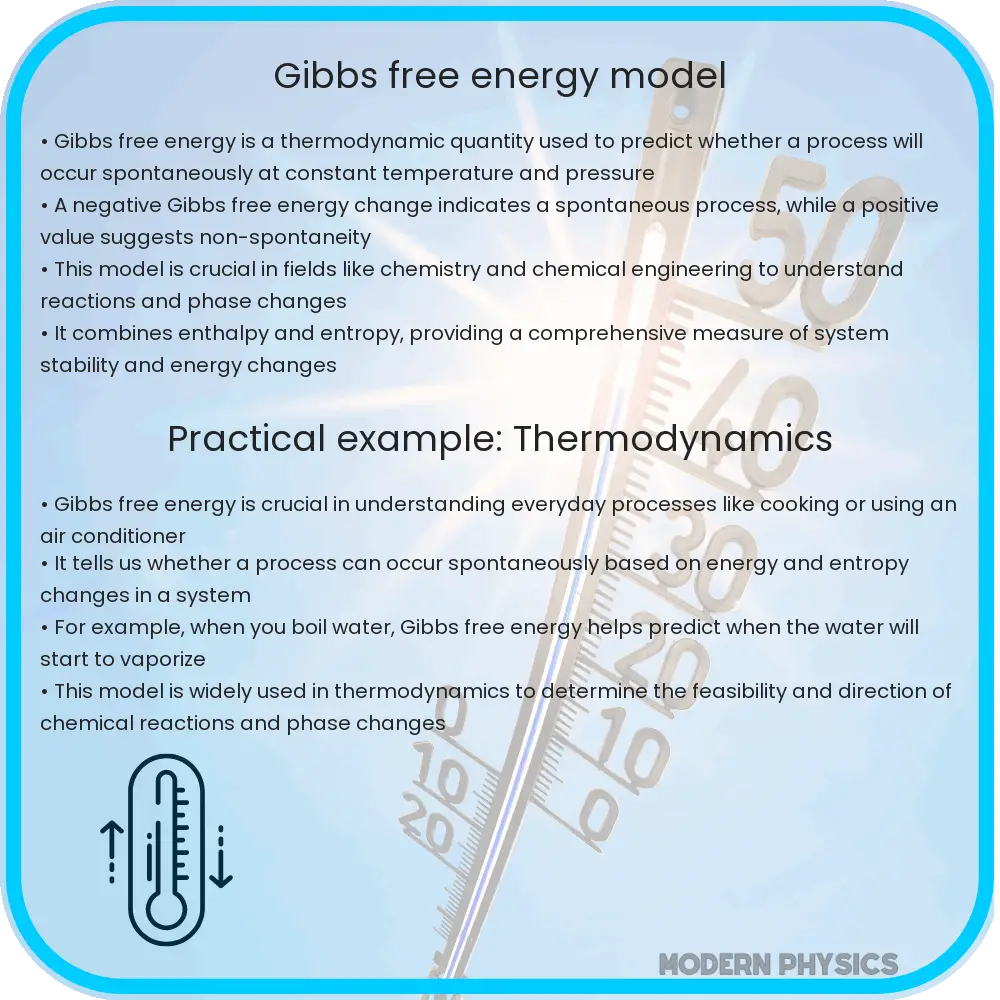Explore Gibbs Free Energy’s role in predicting chemical reactions, efficiency, and equilibrium in scientific and industrial applications.

Understanding Gibbs Free Energy: Fundamentals and Applications
Gibbs Free Energy, symbolized as G, is a thermodynamic property playing a crucial role in predicting the direction of chemical reactions and their equilibria. Named after Josiah Willard Gibbs, it’s a measure of the maximum reversible work that a thermodynamic system can perform at a constant temperature and pressure. This concept is paramount in understanding chemical processes, from simple reactions to complex biochemical pathways.
Prediction of Reaction Direction and Spontaneity
The Gibbs Free Energy formula is given by:
\( G = H – TS \)
where \( G \) is Gibbs Free Energy, \( H \) is enthalpy, \( T \) is temperature in Kelvin, and \( S \) is entropy. A key aspect of this formula is its ability to determine the spontaneity of a reaction. Spontaneous reactions occur without needing continuous external energy input, and they have specific characteristics in terms of Gibbs Free Energy:
- For a spontaneous process, \(\Delta G\) (change in Gibbs Free Energy) is negative.
- For a non-spontaneous process, \(\Delta G\) is positive.
- At equilibrium, \(\Delta G\) is zero.
These criteria are pivotal in predicting whether a reaction will proceed forward or not.
Efficiency and Feasibility in Chemical Processes
Beyond predicting reaction spontaneity, Gibbs Free Energy also indicates the maximum useful work excluding expansion work that can be extracted from a thermodynamic system. This principle is especially important in industrial and biochemical applications where efficiency is key. For instance, in electrochemistry, the Gibbs Free Energy change of a reaction helps in determining the potential of electrochemical cells.
Additionally, the relationship between Gibbs Free Energy and equilibrium is significant in chemical manufacturing. By manipulating conditions like temperature and pressure, chemists can shift the equilibrium position to favor the production of desired products, optimizing yield and efficiency.
Understanding the intricacies of Gibbs Free Energy is not just academic; it has practical applications in various scientific fields, from material science to biochemistry, offering insights into the energetic feasibility and efficiency of chemical reactions.
In the next section, we will delve deeper into the application of Gibbs Free Energy in real-world scenarios, including its role in biological systems and industrial applications, and discuss the limitations of this thermodynamic function.
Applications of Gibbs Free Energy in Real-World Scenarios
The practical implications of Gibbs Free Energy extend far beyond theoretical chemistry, influencing numerous real-world applications:
- Biological Systems: In biochemistry, Gibbs Free Energy is crucial for understanding metabolic pathways. Enzyme-catalyzed reactions, which are the foundation of metabolic processes, adhere to the principles of Gibbs Free Energy. It helps in determining whether a particular reaction in the body will occur spontaneously, playing a pivotal role in energy production and utilization in cells.
- Industrial Applications: In the chemical industry, understanding the Gibbs Free Energy change of reactions is essential for designing processes that are both economically and energetically efficient. For instance, in the synthesis of ammonia via the Haber process, conditions are optimized based on Gibbs Free Energy to maximize yield.
Limitations of Gibbs Free Energy
While Gibbs Free Energy is a powerful tool, it has limitations. It assumes a constant temperature and pressure, which isn’t always applicable in real-life scenarios where conditions can vary significantly. Additionally, it does not account for the rate of a reaction. A reaction with a favorable \(\Delta G\) may still be slow without a catalyst. Therefore, kinetics, alongside Gibbs Free Energy, must be considered for a comprehensive understanding of chemical reactions.
Conclusion
Gibbs Free Energy is a fundamental concept in thermodynamics, offering invaluable insights into the spontaneity, efficiency, and equilibrium of chemical reactions. Its relevance extends from academic understanding to practical applications in various scientific fields, including biochemistry and industrial chemistry. Despite its limitations, the Gibbs Free Energy model remains a cornerstone in the study and application of chemical processes. By providing a clear understanding of the energy changes during reactions, it helps in designing efficient, sustainable, and economically viable chemical processes, contributing significantly to advancements in science and industry.
In summary, Gibbs Free Energy is more than a theoretical construct; it’s a practical tool that continues to shape our understanding of the physical world, driving innovation and efficiency in numerous scientific endeavors.
